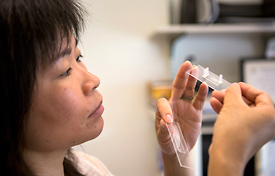For more information:
Related story:
A few more research teams could receive $60,000 to jumpstart early-stage projects. All they have to do is ask for it.
MCubed, the university’s one-of-a-kind seed grant program, has launched 213 interdisciplinary pilot projects since it began last year. The program, which caps off at 225 projects, ends its final funding phase on Aug. 31 so each team has a full year to work on its project. The pilot phase of MCubed is slated to close in fall 2014.
To receive funding, three researchers from at least two different disciplines (that still have funding tokens available) must agree to work together on a new project and register it on the MCubed website. No formal application is necessary.
“This is a prime, but time-limited opportunity to go forward with experimental ideas and early-stage concepts that might be difficult to secure funding for otherwise, but that have a huge potential for success and real world impact,” said Valerie Johnson, MCubed managing director.
MCubed is designed to help researchers forge new collaborations and produce pilot studies that would likely help them establish larger projects. At least one team has already done that, rolling its MCubed project into a broader $2 million grant from the National Science Foundation.
“MCubed was instrumental in bringing us together to start a collaboration we had been discussing for some time. That made a difference — a huge difference. It showed NSF that we were already working together,” said Nina Lin, assistant professor of chemical engineering and biomedical engineering and co-principal investigator of the project titled “Algal biofuel and biodiversity.”
Lin previously had designed a specially etched glass slide, known as a microfluidic reactor, which enables her to grow tens of thousands of different kinds of microorganisms simultaneously. Before MCubed, she had been using the device to see which strains of engineered bacteria would be best for biofuel production, and to study bacterial communities that live in human skin.

Assistant Professor Nina Lin examines microfluidic devices used to create algae communities in order to see what combinations yield the highest biofuel concentration. Photo by Joseph Xu, College of Engineering.
Lin had talked with Bradley Cardinale, associate professor in the School of Natural Resources and Environment, about how a version of her tool might help his research.
Cardinale studies natural communities of algae, and he is looking for communities that can produce more biofuel than the current genetically engineered super-strains. Super-strains, he says, threaten to take over diverse natural lakes and harm ecosystems.
Cardinale has gathered 55 species of algae that represent the most common species in more than 1,000 lakes across the country. To figure out which communities might out-perform genetically modified strains, he has to grow and test species together in different combinations. A version of Lin’s device could help Cardinale more quickly home in on the most promising algae communities for biofuel production.
MCubed moved the two to action. To form a “cube,” they joined forces with Vincent Denef, assistant professor in ecology and evolutionary biology, who will study how bacteria and algae interact to influence biofuel production. They registered the project last fall. It was funded in the first round, which was a lottery. The team set to work.
“Nina was developing the technology as I was writing the NSF proposal,” Cardinale said. “It truly was in real time.”
Lin and her lab weren’t able to completely revamp their experimental set-up in time for their NSF proposal. But that didn’t matter.
“They knew we hadn’t developed it,” Cardinale said, “but thanks to MCubed, we had generated enough preliminary data to suggest that we could pull it off.” The grant is for a broader project, but reviewers told the team they liked Lin’s high-risk/high-reward portion.
MCubed organizers hoped for stories like this when they founded the grassroots program, and they expect to learn about more as the wide variety of teams move ahead.
Teams like “Bioinspired large-scale structural material,” which involves researchers from engineering and natural resources and environment who are making a material that’s stronger than concrete and inspired by an iridescent seashell.
Other teams include “Research hub on college student mental health,” involving professors from medicine and public health, and “Building a bigger, broader creative class,” by faculty in art and design, architecture and social work, who want to inspire creative thinking in struggling cities and towns.
All MCubed projects will give updates on their progress on Nov. 15 at a public symposium titled “The Case for the Cube: How Real-Time Seed Funding Grows Innovation.”

